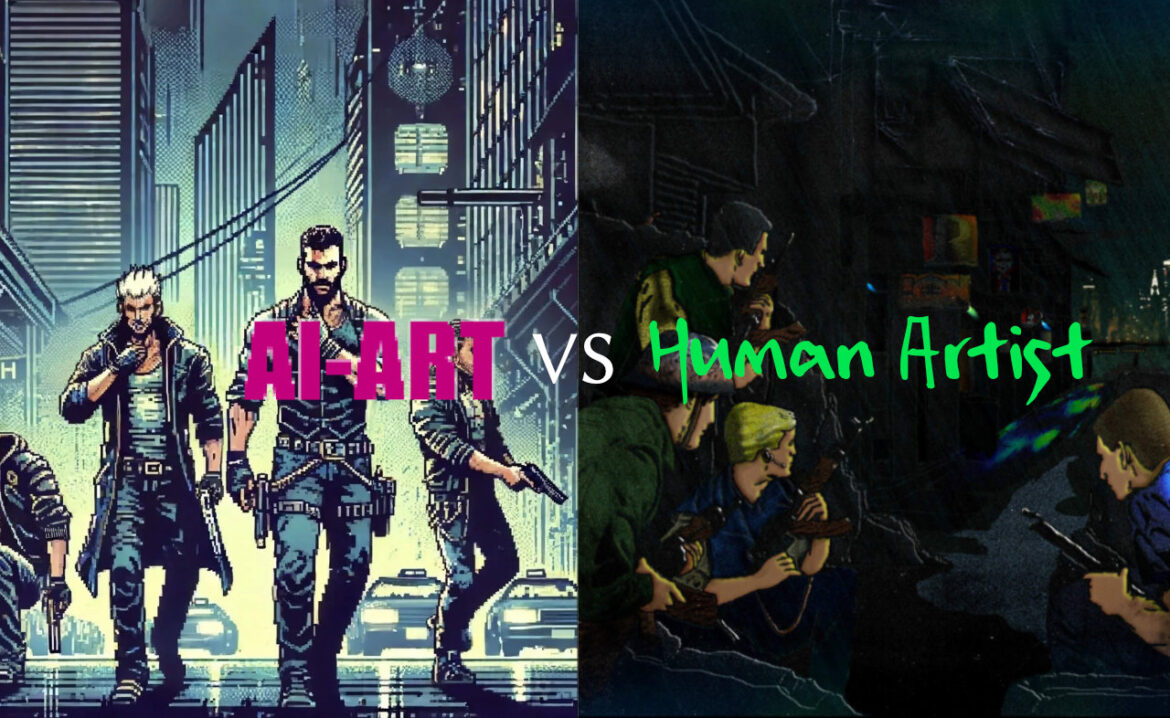By: XEONIQ [ Instagram | Tumblr ]
1. Introduction
It’s 2024 – we are now able to discuss using AI versus human services to create products. More specifically, this article is focused on AI-generated visual art services versus using a traditional human artist to create images for consumer use as media. AI generative visual art has already been disruptive to numerous creative industries, in a very short space of time. From both a futurist perspective and as a consumer, I thought it apt to go through the various aspects of these new machine learning-based technologies, how they may affect us as consumers, and also compare it to commissioning a piece of visual art from a flesh and blood artist.
Generative AI art has now made serious inroads into text, video and music as well, beyond writing and still images. This article will cover only the still image aspect of the technology, from a consumer perspective and introduce the dominant players in the industry right now. I will speculate on the impacts these AI models will have on various industries and then give my impressions using one of the services as a layman. I will also discuss my experiences and impressions with commissioning an art piece from a flesh and blood human artist. We live in an age where AI technology is rapidly developing right in front of our eyes and affecting not just those of us working in creative industries but as consumers of media as well. Understanding such technology and its impacts are an important foundational step in maintaining our cultural literacy in a world where our virtual existence contests with our physical one more and more by the day.
2. On Machine Learning / AI Art as a Service
2.1 The Major Players in AI Art
There are three primary industry leaders for AI-generative art. A brief summary of their ownership and business model is provided below.
2.1.1 DALL-E 3 | Website
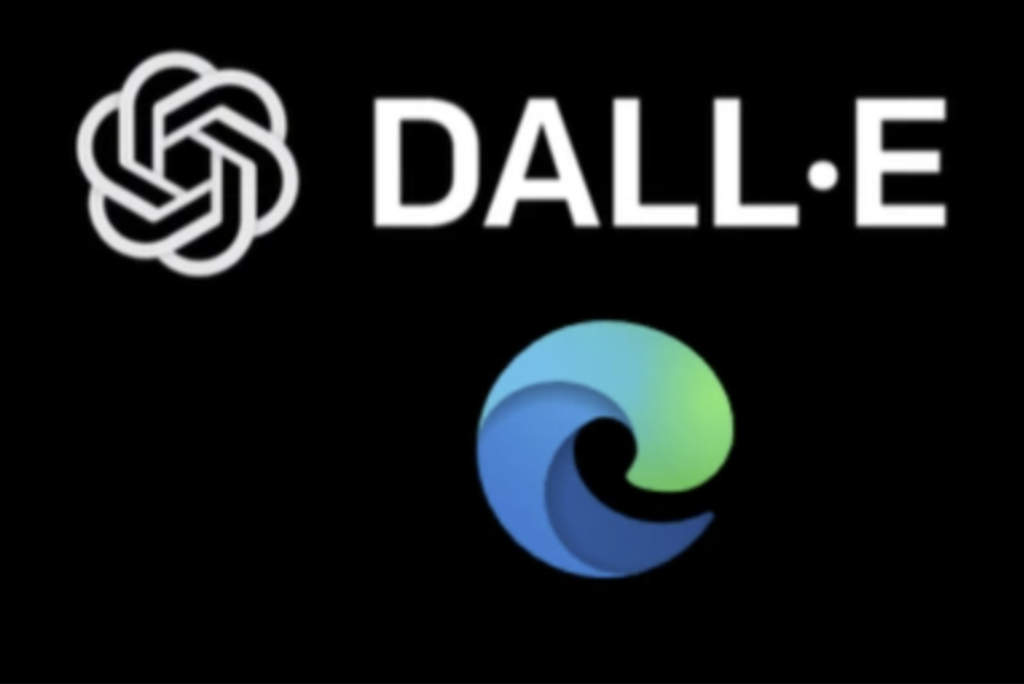
Owner: OpenAI, an AI research lab that initially started as a non-profit and has since shifted to a “capped-profit” model; with both OpenAI and DALL-E now integrated into MicroSoft’s immense technology conglomerate.
Description: DALL-E is a series of AI models capable of generating images from textual descriptions. It is currently on the third generation. The name is a portmanteau of the artist Salvador Dalí and the Pixar movie “WALL-E”. It is known for creating highly imaginative and detailed images based on the prompts it receives. DALL-E 3 is integrated into OPEN-AI’s ChatGPT generative language agent as well as Microsoft’s Bing search and numerous other platforms such as Canva.
Business Model: OpenAI offers access to DALL-E through an API that developers and businesses can integrate into their applications. Users purchase credits to use the service, and there are different pricing tiers based on usage volume. ChatGPT and Bing both have free services to trial creating images with DALL-E 3. It is the most accessible AI Art model for this reason.
2.1.2 MidJourney | Website

Owner: MidJourney, Inc., an independent American company focused on AI research and development and started by David Holz, co-founder of Leap Motion,.
Description: MidJourney is an AI program that creates images from textual descriptions. It is popular for its distinctive style and the quality of its visual outputs, which often resemble high-quality illustrations. MidJourney provides more customisation and specification of images than DALL-E and has significant cloud computing assets to render images quickly for users. Artists would more likely use MidJourney than DALL-E to create custom works for this reason. There is also a strong Discord platform community of MidJourney users who share their creations and work with the developer, which is somewhat unique compared to the other two models.
Business Model: MidJourney operates on a subscription basis, offering different levels of membership that provide users with a certain number of image generation “runs” or queries per month. While MidJourney is currently trialing a web interface for longstanding customers, new users will have to make a Discord account and use that platform in order to use the service. This makes it less accessible than DALL-E, and many refrain from using Discord because of continual privacy and ownership issues, including its extensive problem with the distribution of illegal child sexually exploitative material on its servers and other child safety issues such as “grooming”.
2.1.3 Stable Diffusion | Website

Owner: Stability AI, a company focused on developing AI technologies with a open-source core, started in the UK by financial analyst, Emad Mostaque.
Description: Stable Diffusion is an open-source image synthesis model that generates detailed images from textual descriptions. Its open-source nature allows for wide accessibility and customisation by developers and artists. This is the more customisable model of the three options discussed here and hence the most used by visual artists. Keeping the content hosted locally provides enhanced privacy and allows the artist to train its data set and make tools that are specific to their use cases. The open-source aspect of Stable Diffusion has enabled widespread misuse with pornographic output featuring real people known as “Deep Fakes”, and proprietary and copyright material misuse, which appear to be more protected by DALL-E and MidJourney’s terms of service, policies and the virtual processes they dictate affecting the virtual service.
Business Model: Although the core model is open-source and free to use, Stability AI offers commercial licenses and partnerships for businesses requiring large-scale deployment or custom solutions. Like DALL-E’s implementation on ChatGPT Stability AI now has “Stable Assistant” which can create images via a similar chat-bot interaction method starting at $USD9 / month.
There are a large number of other AI Generative Art services not included here for brevity such as RunwayML and Joel Simon’s Artbreeder, many of which use cloud computing of one of the three main AI Art models such as Stable Diffusion to provide users with a client interface to create their own images.
2.2 Using a Generative AI Art Service as a Layman Consumer
The most accessible of the three models was DALL-E. I interfaced with it via ChatGPT and fed it prompts for around 45 minutes of a similar nature and content to the creative brief I provided the human artist for the paid commission I will detail below. The results were… not good. Inexperienced with prompts, no matter how specific or generic I made my requests with ChatGPT, it always seemed to provide a very “AI Art” aesthetic image that were largely without imagination and looked unsurprisingly like tens of thousands of AI-generated images I’ve seen over the past two years online. Sometimes the results were amusing in a random kind of way, but it never captured the kind of graphic, gritty illustration that I wanted. Despite asking for action type scenes, I was almost always presented with a kind of posed group portrait. The “best” outcome I managed with modifications to my prompt that I gave a human artist is below. The strange smooth smears over the pixelated texture of most of the image makes it look like a cut and paste photoshop edit, to me. The colours as well feel distinctly machine generated, which I suppose is a perception I’ve picked up being exposed to AI Art online the last year or two.
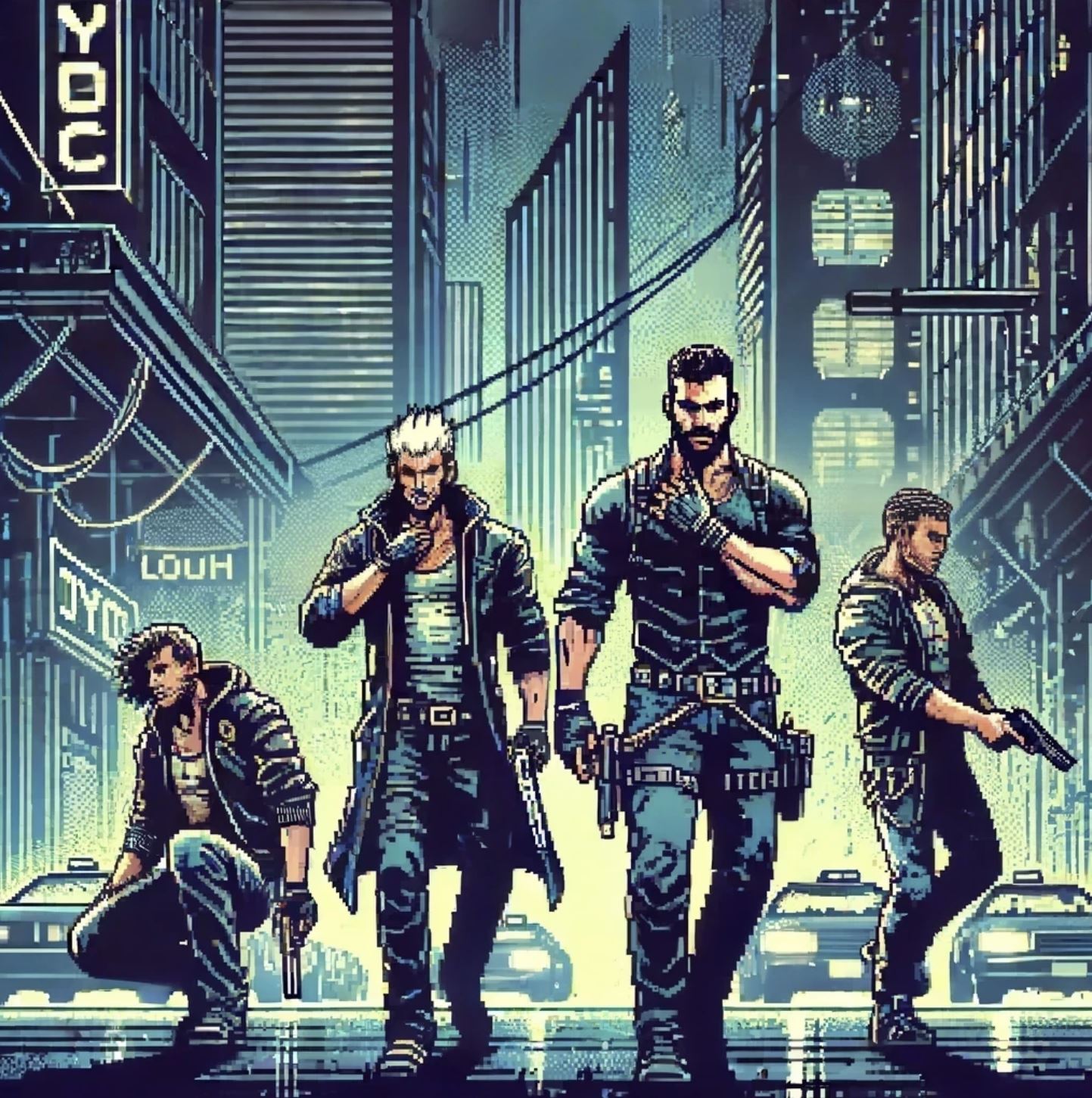
I felt confident I could use DALL-E to create generic stock art illustrations for a presentation or a flyer, but in terms of “art” that I would personally feel interested in seeing, I don’t think I could possibly create any with this model. I am sure that talented artists using DALL-E and other models like Stable Diffusion, which seems more suited to specific artist use, could definitely generated some aesthetically remarkable images; but as a layman consumer that was completely out of my range of abilities and thus the service was no more than a novelty.
In the past I might have taken the position that as consumers we must “stay in our own lane”. At this introductory phase of AI art, that might still be a good idea. Despite being relatively experienced with image editing software, I did not find it relatively easy or rewarding creating my own AI art ideas. I imagine an artist experienced with these tools could use them quite proficiently though. In the near future though, these tools will get better, and their interface, not just the output will be vastly improved and laymen consumers will be able to create images as they image them. The question is, if freely made, superb quality images are distributed so effortlessly online, will we still even care at that point?
2.3 The Impact of AI Generative Art on Different Industries
There has been significant, negative, reaction to machine learning art generators from various stakeholders. One of the more vocal groups are those who provide commissioned artworks and promote their service on social media networks such as Instagram and X (formerly Twitter). Said social media platforms opened up a new industry of independent artists who could market their services directly to non-artist consumers, and often niche communities, in a way that was not possible before advent of the internet. One issue, in my opinion, with websites such as Deviant Art is that they are a space primarily for artists. What that means is that there is an awful lot of show and tell among peers, and not a lot of marketing to laymen consumers who vastly outnumber artists and who are more likely to purchase a piece of art as a print or commission a digital version to be made. Instagram and X provided that.
Although I couldn’t create anything I’d call interesting using DALL-E, there are many skilled AI Art users who are now able to rapidly produce art for this art buying market on social media. While many of these may have already been creating art commissions and simply used the tools to vastly increase their output, there were many who lack the technical background to illustrate or colour, but who were capable of using a trained AI model to produce digital still images in a way that consumers wanted. Sometimes that also meant mimicking an artistic style that a prominent community digital artist was using. This has prompted outrage as this short-lived independent digital artist industry has now been cannibalised by AI art model-assisted creators.

(DALL-E in this case) that is making “Stock Photo” art for sale redundant
For those who never had access to formal fine art educations, publishing networks or commercial distribution channels, this seemingly overnight loss has been traumatic. Being able to earn money by using ones own artistic gifts was one of the many gifts bestowed on society by the internet, and AI art’s ability to reduce time and effort to create such works and mimic others’ styles to such an exacting degree has taken it away. For those genuinely creative artists with the audience and ability, AI generated art tools could well be a boon in this market, able to continue creating with a previously impossible output and even use them to do new kinds of art, such as animation that was not possible before.
But AI generated visual art models have not only just impacted this commissioned digital art market. Many corporate businesses have jumped at the chance to vastly reduce their budgets on third party imagery providers or internal art departments.
Areas where I would suspect there to have been or will soon be considerable commercial upheaval due to AI generated art:
- Stock Photo Creation and Distribution Websites:
- Selling images for e-commerce, news sites, PowerPoint presentations, and so on. AI can generate a vast array of images that can mimic traditional stock photography, potentially reducing the demand for photos taken by human photographers. This technology can produce diverse images tailored to specific themes or subjects on demand, reducing the reliance on extensive stock photo libraries, which were purchased for commercial use on demand. Photographers and the stock photo distribution websites are perhaps even more negatively affected by AI generated art than any other group as stock photography is less “art” and more a representative image that is “good enough” to communicate a concept.
- Advertising as an Industry:
- Advertising agencies and departments could use AI to quickly generate and modify ad imagery and layouts, reducing the need for human graphic designers for routine tasks. This shift could affect freelance graphic designers, smaller design studios and the human resources employed by internal corporate department the most, as larger agencies may adopt AI tools to cut costs and increase production speed, potentially leading to a decrease in contracted human-created work.
- Graphic Design as a Service and as a Profession:
- AI can automate many elements of graphic design, such as logo creation, layout design, and even complex branding projects. This enables non-designers to produce work quickly that would traditionally require a professional designer. While AI can enhance the productivity of skilled designers, it might also commoditize certain types of design work, particularly those that are more formulaic and less dependent on unique creative input.
- Digital Re-touching Services:
- AI tools are already capable of performing routine photo editing tasks such as colour correction, object removal, and skin retouching more swiftly than human operators. Professional retouchers, particularly those working in fashion photography and advertising, undoubtedly have seen a decrease in demand for their services as AI becomes more adept at performing these tasks automatically and with high precision, with many creative suites such as Adobe’s range of products integrating automated tools into their own software.
- Illustration and Concept Art:
- AI can generate concept art and illustrations rapidly, which could impact illustrators and concept artists, especially those working in video games, films, and other types of media. These industries rely heavily on unique artistic visions that AI tools are increasingly able to mimic. In this case, I imagine they provide creative artists with a much faster output for their clients and innovation, which AI generated models mostly lack, is not currently capable of completely replacing.
- Fashion Design:
- AI tools are capable of generating clothing patterns and designs, potentially affecting designers who traditionally perform these routine tasks. AI can rapidly produce a wide range of designs based on current trends, which could streamline some parts of the design process but also threaten jobs in an already challenging industry for creatives. As fashion itself becomes dumbed down, we could see the middle and budget markets slowly replaced by trend-fed AI where the focus is on cost savings and “fitting in” with a prominent brand logo more than it is about conceptual design or personal stylistic differentiation.
- Architecture and Interior Design:
- AI models can also assist in creating architectural renders and interior design layouts quickly, which might aid many professionals in these fields but also reduce the demand for more routine human created art work, which the tools replace. While this can enhance productivity, it most likely will reduce the demand for human labour.
- Animation:
- With AI tools able to animate characters and scenes with increasing sophistication, the technology is already disruptive to traditional animation processes that had been long computer-aided even before recent AI model breakthroughs. Animation studios should see faster production with less staff, but will still require innovative and creative directors and concept artists to lead the automation-assisted studio.
- Publishing:
- AI-generated art can be used for book covers, illustrations, and marketing materials in the publishing industry. This could reduce costs and time associated with these creative processes, potentially impacting freelance artists and design firms that typically handle such tasks. While these tools might seem to be a boon for authors who could not otherwise afford a professional looking cover artist or graphic designer, the fact that many AI generative art produced images have a very distinctive look to the, especially if produced by a layperson, may make doing this a bad idea if the goal is to stand out.
It’s clear that like it or not, as consumers, we will continue to see a lot of AI-generated images in many industries, and for those working in said industries, there is a significant chance you will be impacted by this technology if not using these tools already.
3. On Commissioning with a Human Artist
Now, from the perspective of a consumer, my takes on the supposed opportunities and threats to artists that machine learning models present wouldn’t be worth much if I couldn’t put my money where my mouth is. We live in a time where media of all varieties are available to us 24/7, cheaply, or even free if you know where to look. The media of the day is multi-dimensional, games and even streamers are interactive, there is so much variety that many, if not all of us, suffer to some degree of information overload. In comparison, commissioning a piece of static visual art, one that could be potentially generated by a machine learning model, for a not-inexpensive sum of money, and then having to wait for it for weeks if not months depending on the artist, is pretty much the polar opposite of most consumers’ current relationship with still image media.
I am more a reader than I am a watcher and I admittedly spend more time creating with my photography hobby than I do consuming art. So, the digital image I commissioned for this article, to compare the experience as a consumer with my somewhat humorous but also frustrating attempt at using DALL-E, was my first time commissioning a piece of art.
One independent artist whose work I’ve enjoyed is Georg Jutvall [ Instagram ]. I interviewed him two years ago for a SHELLZINE article where we talked about his methods, his inspirations and the practical aspects of promoting his work on social media for other artists to consider. I liked his work, I had previous experience interacting with him via e-mail, which made things easier in terms of providing him with a brief, and I felt his art was a good match for this site and its audience with its vaguely futuristic and dystopian scenes and lo-fi, action-oriented characters that look straight out of a 90’s sci-fi flick.
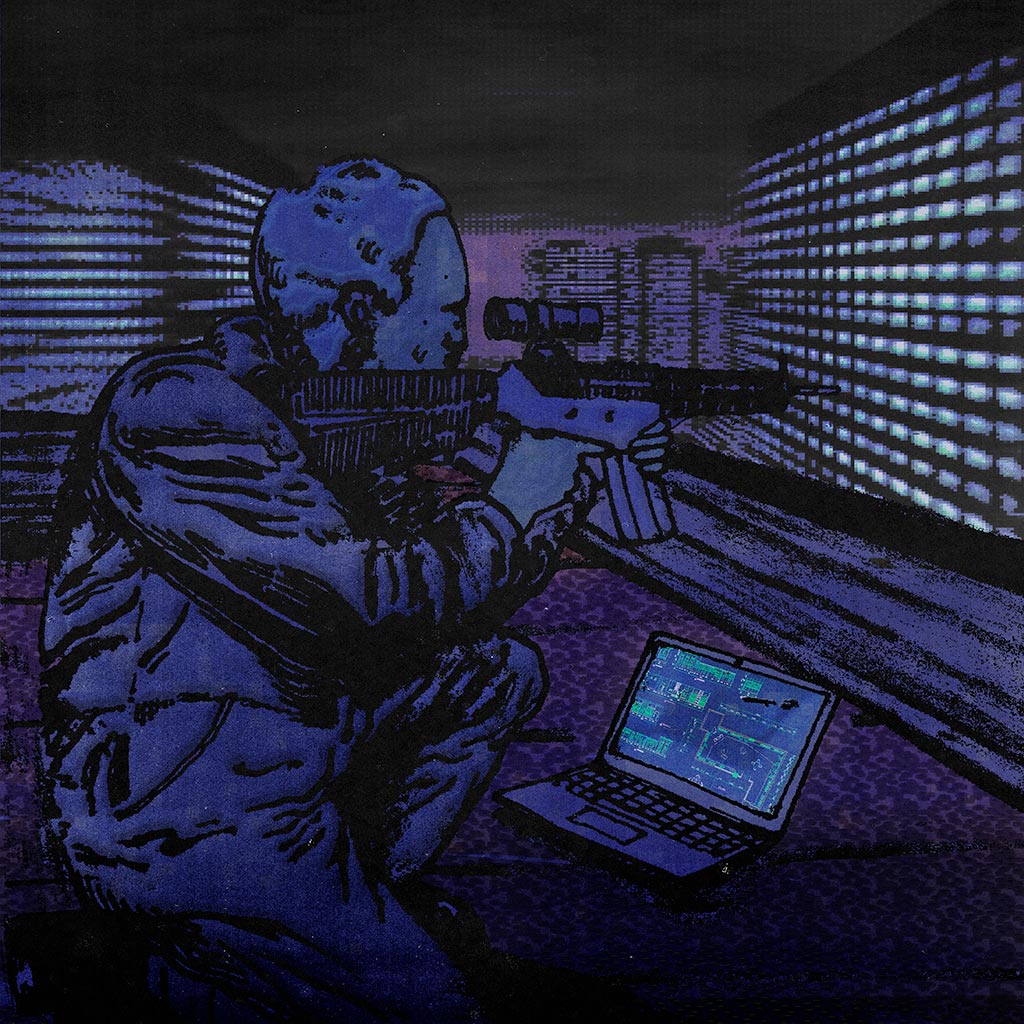
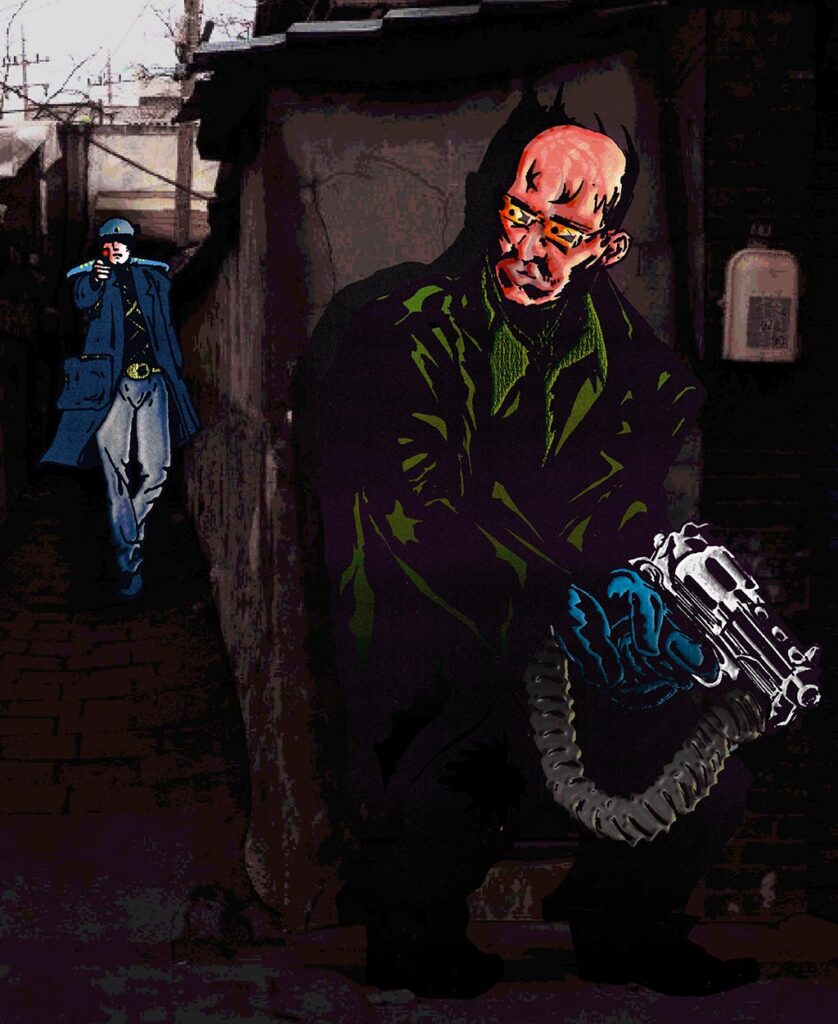
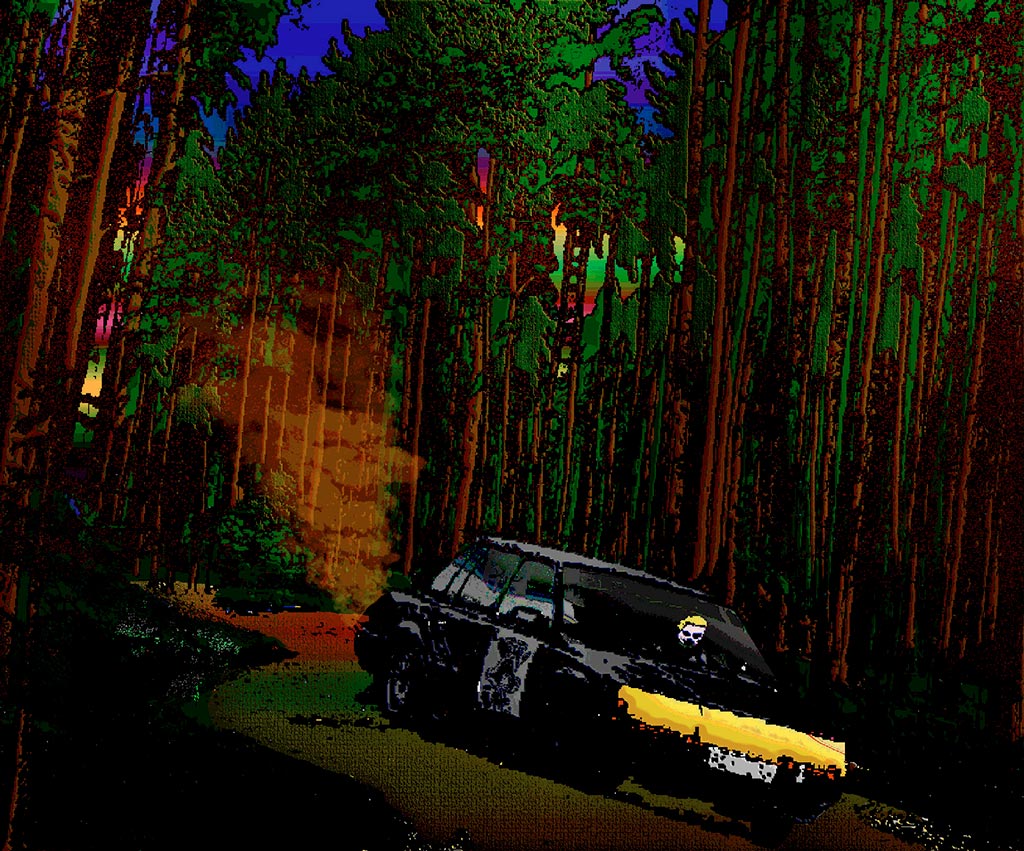
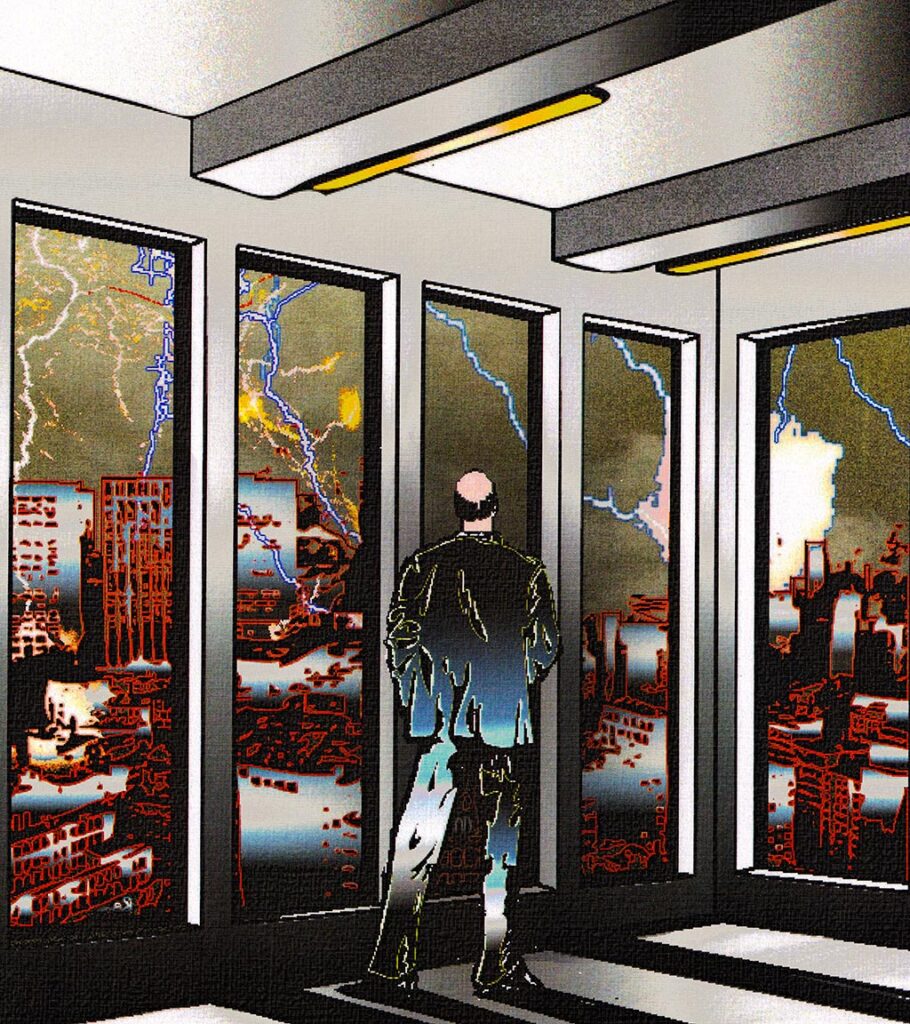
I gave Georg a brief with a few screen shots from various movies I was inspired by, requesting that myself and a few friends by illustrated in an urban scene, one that had a degree of activity in it that could not be so easily posed for a photograph; as I have plenty of photos of myself and friends thanks to my hobby. He would create the piece by hand and then provide me with a high-resolution digitization that I could print if I desired. There were no other stipulations and I wanted to give Georg creative freedom so that he would feel stifled or produce work that did not personally interest him.
After a little back and forth to clarify things, I paid a deposit and in a few months the final product was ready.

I was very happy with the result. There is something of me in it. The inspiration materials I provided, the idea that the artist himself had of me, the communications regarding the work, they all culminated in the final piece; which at the end of the day is still very much in his own artistic style. The anticipation of waiting to see how this custom work turned out was not dissimilar to how I feel while waiting to receive one of the made to order garments from my partner Gracia’s brand, ROSEN-X. While still images, either digital illustrations and paintings or photographs, as art have doubtlessly been impacted by the sheer volume provided by the internet, fashion too has also been affected by this 24/7 excess of choice to consume provided by online shopping. From this perspective in 2024, the anticipation of being forced to wait actually has become somewhat of a benefit as a consumer rather than a drawback.
So is there value in waiting longer, in paying more, in having to communicate and interact with a real person that creates your art or makes your clothes? Having to talk to Gracia or to Georg about what I had imagined, that is a necessary social interaction. These aren’t sterile “products” that are belted out on an assembly line, designed by marketers and accountants for a “target audience”. They are unique pieces made for me. And that makes them all the more enjoyed by me. From a practical perspective, there was about as much chance of me making the custom artwork that Georg produced for me, even using AI art models as I would have designing and sewing together my ROSEN-X Aeon jacket. Even if I could achieve the aesthetic quality with an AI model, I would not have imagined the scene, the poses, the light or the colours, in the exact same way.
4. AI Generated Art: A Tool or a Threat to our Future?
So what does all this mean as a consumer? The AI generative art technology does not seem accessible enough at present, when wielded by a layman, to rival a human, or AI-assisted human artist, in my opinion. Technology, particularly if it is accessible, is a Pandora’s Box. Artists will have to cope with its existence, if not use it themselves to adapt to the market. Outside of complete government-enforced bans, even wide scale consumer boycotts of AI generated visual art are not going to help stop it. The market itself is certainly being changed too, and I know I have grown a distaste for the AI art “look”, while two years ago I simply was indifferent to it. Seeing something too much can turn us off, as consumers. At the end of the day, the mass of laymen consumers are going to dictate what is popular and what we want to consume, as media or as products. If AI art devastates our ability as an audience to appreciate static visual images, then it could be argued that new mediums of expression will evolve to communicate with us and capture our attentions.
The acceleration of technology as a tool for expression has long been observed as software like photoshop and smart phone filters, both real time built into camera apps and post-processed, created “elevated” depictions of reality. At the higher end of commodified corporate “art”, in many movies today, post-processing filters are added to extend the youth of ageing actors, whose value as their own brand to studio productions greatly exceeds the costs of giving hopeful young actors a chance to star in a film. Thus even the ability to depict reality using traditional tools such as a paintbrush and canvas or a camera and film may become hopelessly outmoded by machine learning generated algorithms that can create visual depictions faster, with less effort and resources, and in a manner that is closer to the artist’s intended vision. I say “may become” but that is perhaps disingenuous. These tools have already become better. An inexpensive digital camera that is heavily augmented with computer assistance can outperform even a large format film camera with the best operator in terms of technical quality. As this AI technology continues to evolve and improve, the individual resources needed to use it will only be reduced to subsume the user into controlled platform eco-systems. The ability for a modern smart phone camera, which most developed world consumers have access to, to take portraits that are competitive with a professional 35mm film photographer just a decade or two ago is an apt example of this. But while this may seem a kind of democratisation, for any liberal individualist who enjoyed the meritocracy provided by human-made and digitally distributed artworks, of any medium, AI-generated art, controlled by a small handful of ever-improving corporate algorithmic models, presents an ideologically terrifying threat for the future.
And yet, the biggest threat that AI Art has for our future, to me, is not that it is used to plagiarise real artists or the depictions they want to create. While that is a negative outcome, the real threat posed by AI Art, is what it will do not to artists but to everyone else: the audiences. If the proliferation of AI art becomes perfectly normalised we may lose value in consuming imagery that is inspiring, fantastical or romantic. Even worse, we may lose the ability to differentiate between what is real and what is not: how we see ourselves in our smart phone portraits becoming more real than a mirror’s reflection. The AI-generated images of an event or news of war overseas can become a more accurate representation than footage streamed live using a just-as-technologically-manipulated phone camera. We weren’t there anyway, and for those that were: their perspectives of reality have to compete with much more visually enticing and resource efficient AI-generated imagery which can be generated infinitely until the whims of its masters are satisfied. And I’d argue that giving the power to alter and control how we visually conceive reality to centralised black box technologies that are owned and wielded by and for elite interests cannot be in the interests of the common man.
If you enjoyed this article, supporting SHELLZINE by any amount can be made via the link below. Your contribution is completely optional and all funds help cover the website’s growing hosting costs and enable further original content creation without the use of advertisements. Secure payments by all major card types, including Google Pay and Apple Pay, are supported.

